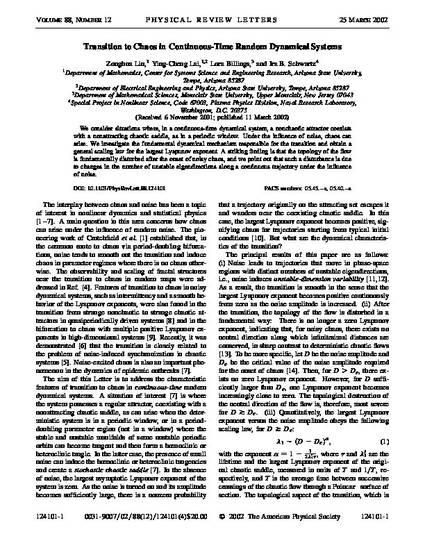
Article
Transition to Chaos in Continuous-Time Random Dynamical Systems
Department of Mathematics Facuty Scholarship and Creative Works
Document Type
Article
Publication Date
3-1-2002
Disciplines
Abstract
We consider situations where, in a continuous-time dynamical system, a nonchaotic attractor coexists with a nonattracting chaotic saddle, as in a periodic window. Under the influence of noise, chaos can arise. We investigate the fundamental dynamical mechanism responsible for the transition and obtain a general scaling law for the largest Lyapunov exponent. A striking finding is that the topology of the flow is fundamentally disturbed after the onset of noisy chaos, and we point out that such a disturbance is due to changes in the number of unstable eigendirections along a continuous trajectory under the influence of noise.
DOI
10.1103/PhysRevLett.88.124101
Published Citation
Liu, Z., Lai, Y. C., Billings, L., & Schwartz, I. B. (2002). Transition to chaos in continuous-time random dynamical systems. Phys Rev Lett, 88(12), 124101. doi:10.1103/PhysRevLett.88.124101
Citation Information
Zonghua Liu, Ying-Cheng Lai, Lora Billings and Ira B. Schwartz. "Transition to Chaos in Continuous-Time Random Dynamical Systems" (2002) Available at: http://works.bepress.com/lora-billings/32/

This article originally appeared in Physical Review Letters (ISSN 0031-9007, ESSN 1079-7114), and is posted in accordance with the Institutional Repository guidelines set by APS. The publisher copy is available online at: https://doi.org/10.1103/PhysRevLett.88.124101